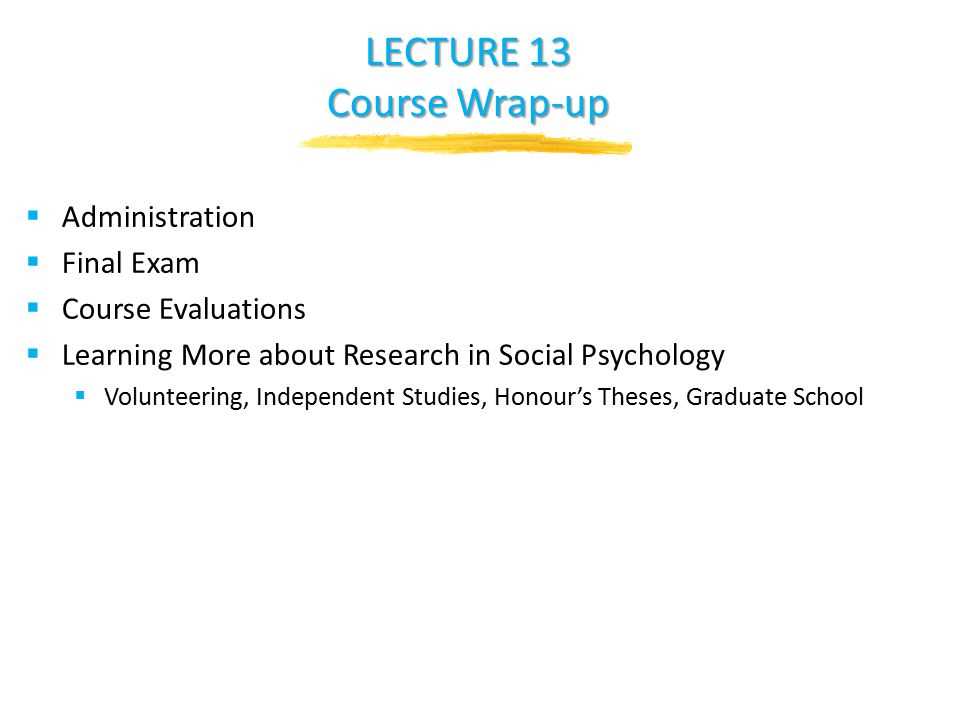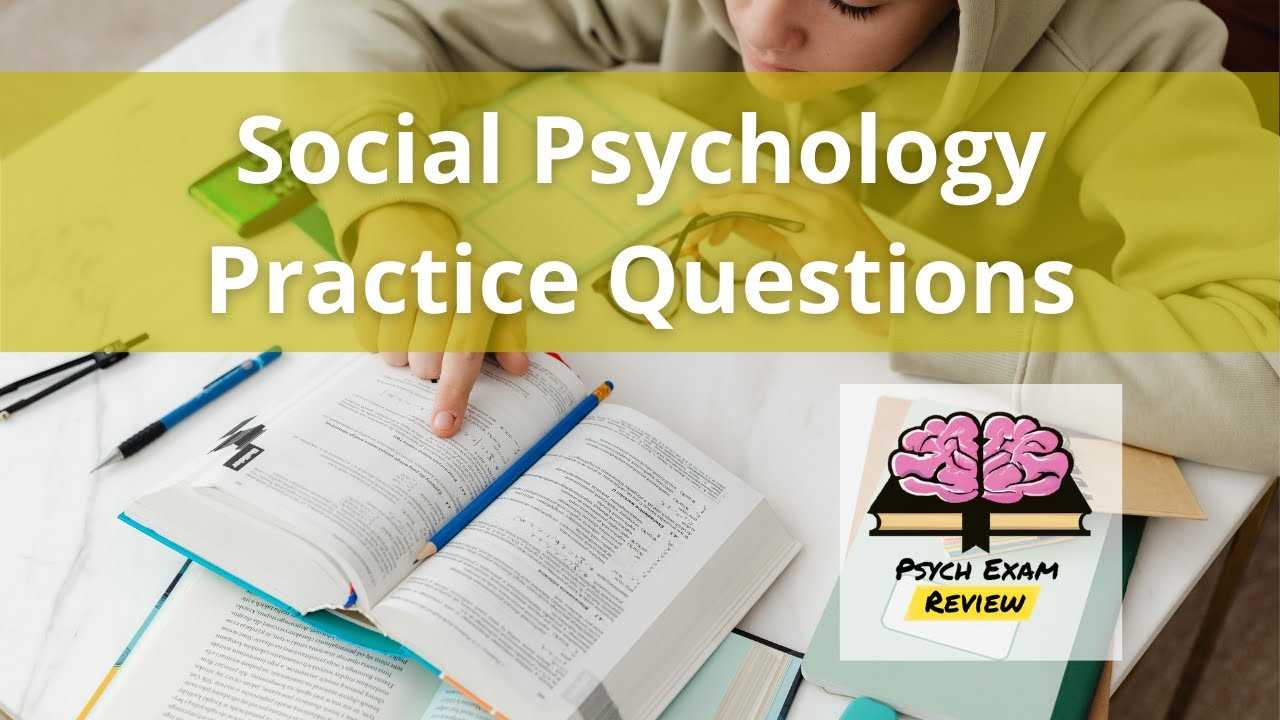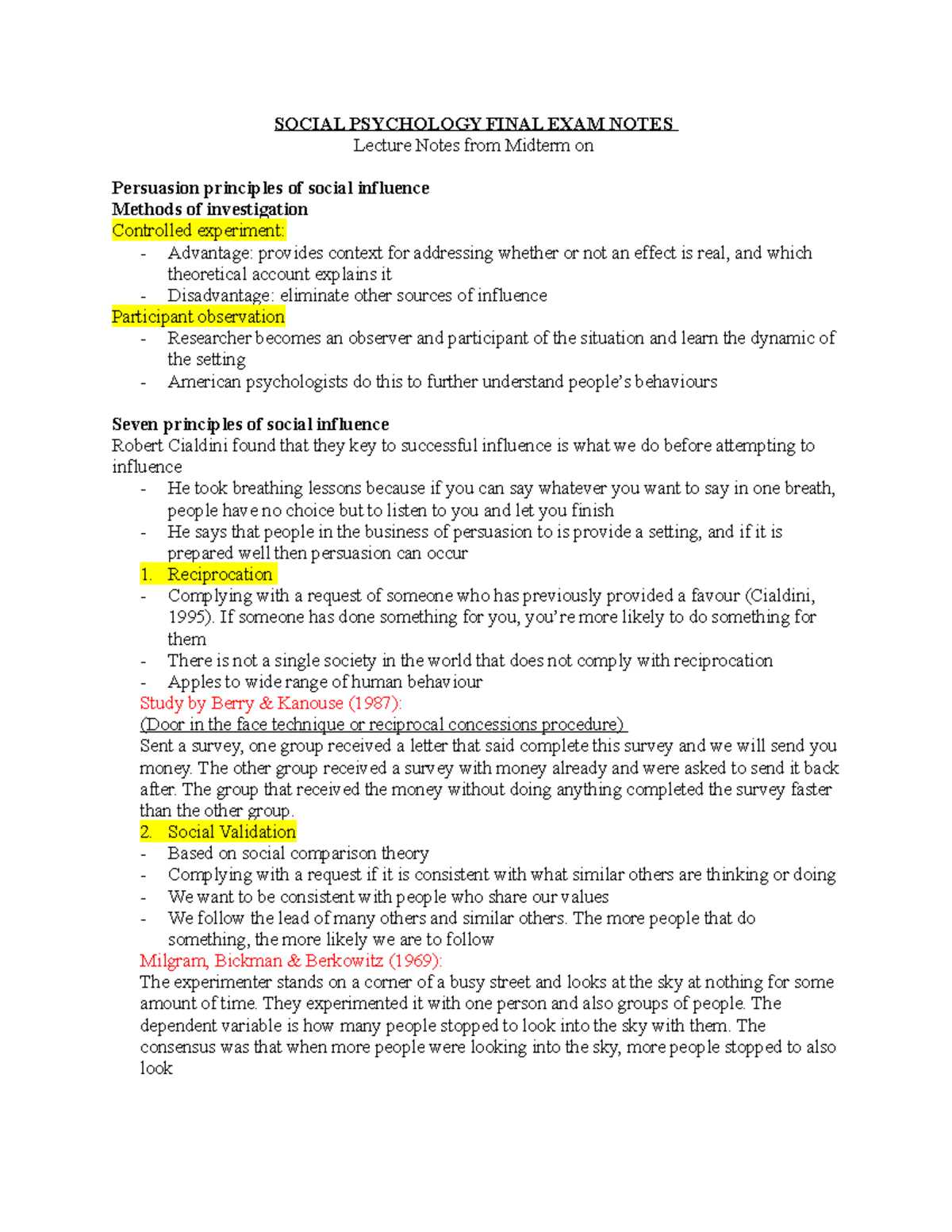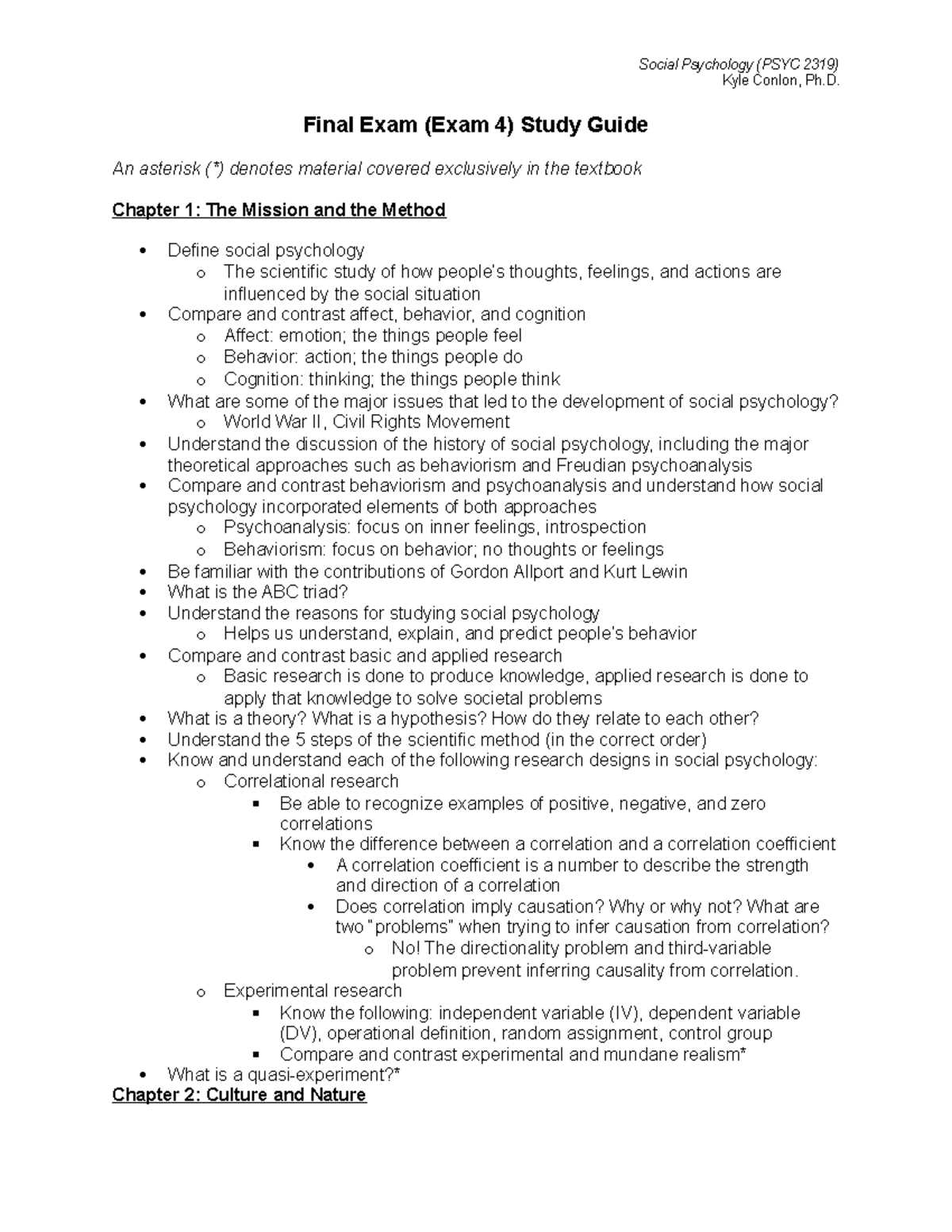
Understanding human actions within a group or individual context is crucial for mastering key principles in this field. By exploring various factors that influence thoughts, emotions, and interactions, you can develop a deep understanding of how individuals behave in different settings. This knowledge is not only fundamental for academic success but also for practical applications in real-world scenarios.
Mastering the material requires more than memorizing theories or research studies. It involves connecting these concepts to everyday experiences and recognizing the patterns that guide human behavior. By doing so, you’ll be able to navigate the complex relationships between individual actions, group influence, and societal norms with ease.
Through this guide, we will explore essential concepts that are integral to your understanding and preparation. From the impact of group dynamics to the influence of media on decision-making, each section will provide valuable insights that will help you excel in your assessments.
Social Psychology Final Exam Overview
In order to succeed in understanding the complexities of human behavior within groups, it’s essential to focus on a broad range of concepts. This includes how individuals are influenced by others, the role of attitudes and beliefs, and the effects of societal norms on behavior. The assessment will test your knowledge across these areas, requiring both theoretical understanding and the ability to apply this knowledge in practical situations.
Key Areas of Focus
Preparation for this assessment involves a comprehensive review of the foundational concepts, research findings, and key theories that define human behavior in social contexts. Grasping the interplay between individual actions and group influence is critical for understanding how people think, interact, and make decisions in various environments. Below is a summary of the essential topics you should be familiar with:
| Topic | Description |
|---|---|
| Attitudes and Beliefs | The formation, change, and impact of personal attitudes and beliefs in different settings. |
| Group Behavior | How group dynamics, such as cohesion and conformity, affect individual decisions and actions. |
| Interpersonal Influence | The mechanisms of persuasion, compliance, and obedience in social interactions. |
| Prejudice and Discrimination | Understanding the causes and consequences of biased attitudes and behaviors towards others. |
| Prosocial Behavior | Factors that encourage or discourage helping behaviors in different contexts. |
Study Strategy

To effectively prepare for the assessment, prioritize understanding the key themes and real-world applications of these concepts. Reviewing research studies and their outcomes will help you apply theoretical knowledge to practical scenarios. Use active recall techniques and practice applying these ideas to everyday situations to reinforce your understanding.
Key Concepts to Master
To succeed in understanding human interactions and behavior, it is crucial to master the fundamental ideas that shape how individuals think, feel, and act within various environments. Focusing on core principles such as the influence of groups, personal attitudes, and interpersonal dynamics will allow you to build a solid foundation. These concepts are essential for understanding why people behave the way they do in different situations and contexts.
| Concept | Description |
|---|---|
| Group Influence | The effect of groups on individual actions, including conformity, obedience, and groupthink. |
| Attitudes and Behavior | How personal attitudes form, evolve, and influence behavior in social situations. |
| Perception and Bias | The ways in which individuals perceive others and how biases shape these perceptions. |
| Interpersonal Relationships | How attraction, communication, and conflict affect relationships between individuals. |
| Prosocial and Antisocial Behavior | Understanding the motivations behind helping others or engaging in harmful behaviors. |
Familiarizing yourself with these concepts and recognizing their application in real-life situations will help you approach the subject with confidence. Each of these topics is central to understanding human interactions and will provide valuable insights into why individuals behave in specific ways within groups or in response to external factors.
Understanding Social Influence and Behavior
Human actions are often shaped by the presence, expectations, and behaviors of others. Individuals frequently adjust their thoughts and conduct based on external influences, whether consciously or unconsciously. These interactions can be influenced by group dynamics, societal norms, and interpersonal pressures, all of which play a significant role in shaping decisions and actions within different environments.
The ability to understand how individuals are swayed by their surroundings is essential in grasping why certain behaviors emerge in particular settings. Factors such as conformity, compliance, and obedience are central to understanding how external forces guide actions. These influences are not always obvious, yet they hold significant sway over personal choices and behavior.
Grasping the key elements of influence allows us to see how actions are often responses to external pressure, whether from friends, authority figures, or broader societal expectations. Recognizing the psychological mechanisms at play helps explain why people behave differently in group settings or under specific social conditions.
The Role of Attitudes in Social Psychology

Attitudes play a crucial role in shaping how individuals think, feel, and act in various situations. These mental frameworks influence not only how people perceive the world but also how they interact with others. The beliefs, evaluations, and feelings individuals hold about different objects, people, or events can significantly affect their behavior, often guiding decisions in subtle ways.
Understanding attitudes is key to unlocking why people behave in certain ways in social contexts. These attitudes can either align or conflict with the actions they take, creating a complex dynamic between thought and behavior. The strength and direction of these attitudes often determine how individuals engage in group settings or react to external influences, from peers to societal pressures.
Changing attitudes can also have a profound impact on behavior, as shifts in belief often lead to shifts in actions. Persuasion, cognitive dissonance, and other mechanisms are involved in how attitudes evolve over time. Recognizing these processes is essential for understanding how individuals adapt their behavior to align with their attitudes or the attitudes of those around them.
Group Dynamics and Groupthink
Groups often shape the behavior of individuals in ways that would not occur in isolation. The interactions, norms, and roles within a group can deeply influence how members think, act, and make decisions. Understanding these group processes is crucial for recognizing why individuals sometimes act in ways that reflect the desires or pressures of the collective rather than their personal beliefs.
One of the key phenomena within group settings is groupthink, a psychological pattern where the desire for harmony or conformity in a group results in irrational or dysfunctional decision-making. In an effort to avoid conflict, group members may suppress dissenting opinions, fail to critically analyze alternatives, and make decisions that they might not have individually chosen. This often leads to poor outcomes, as the group’s cohesion becomes more important than the quality of the decisions made.
The study of group dynamics helps us understand these processes and how they affect decision-making, leadership, and problem-solving. By recognizing the factors that contribute to groupthink, such as high group cohesion or pressure from authority figures, we can better navigate and manage group interactions to ensure that diverse perspectives are heard and considered.
Social Identity Theory Explained
Individuals derive part of their self-concept from the groups they belong to. These group affiliations not only provide a sense of belonging but also influence how people perceive themselves and others. The theory that explains this process is centered on understanding how group membership affects personal identity and interpersonal interactions. It explores how individuals classify themselves and others based on group characteristics, leading to behaviors such as in-group favoritism or out-group discrimination.
The Formation of Group Identity
Group identity is formed through shared experiences, values, and social connections. As individuals associate themselves with specific groups, they adopt the group’s norms, attitudes, and beliefs, which shape their sense of self. This identity influences behaviors such as loyalty, cooperation, and competition. Understanding how group identity develops helps explain the strong emotional connections people feel toward their communities, whether they are based on nationality, religion, or social circles.
Impact on Intergroup Relations
The way individuals perceive their own group in relation to others can lead to various outcomes in group interactions. When group identity is strong, it can foster unity and support within the group, but it may also lead to prejudice and discrimination against outsiders. These dynamics are often observed in competitive or conflicting environments where group members view their interests as opposed to those of other groups.
Persuasion Techniques and Strategies
Persuasion is a powerful tool that influences attitudes, beliefs, and behaviors. It involves the use of various techniques and strategies to convince others to adopt a particular viewpoint or take specific actions. Understanding these methods allows individuals to navigate interactions more effectively, whether in marketing, negotiations, or everyday communication. The process of persuasion can be subtle, relying on both emotional appeals and logical arguments to sway an audience.
Common Persuasion Techniques
There are several established methods used to influence others, each tailored to specific contexts and goals. Some techniques focus on appealing to the emotions, while others are based on presenting facts and logical reasoning. Below is a table that summarizes the most widely used persuasion methods:
| Technique | Description |
|---|---|
| Reciprocity | Offering something of value to create a sense of obligation in the other person. |
| Authority | Using credible sources or experts to back up a claim and increase trustworthiness. |
| Scarcity | Creating a sense of urgency or limited availability to increase desire. |
| Social Proof | Using the actions or opinions of others to convince someone to adopt a behavior. |
| Consistency | Appealing to a person’s desire to appear consistent with past actions or statements. |
Effective Application of Strategies
To maximize the effectiveness of persuasion, it’s essential to match the strategy with the audience and context. A carefully crafted message, delivered by a trusted source, is more likely to resonate and achieve the desired outcome. Additionally, understanding the psychological mechanisms at play–such as cognitive biases and emotional triggers–can help refine persuasive efforts and increase their success rate.
Conformity and Obedience Research Findings
Research into human behavior has shown that people often adjust their actions and attitudes to align with the expectations of others or to comply with authority figures. This tendency to follow group norms or obey instructions, even when it contradicts personal beliefs, reveals significant insights into human behavior. The findings from various studies highlight the powerful influence of group pressure and authority, often leading individuals to act in ways they might not otherwise choose.
Numerous studies have explored the dynamics of conformity and obedience, providing valuable understanding of how individuals yield to societal expectations or directives from those in positions of power. These studies illustrate the delicate balance between personal autonomy and the desire to fit in or follow authority. The impact of these influences can range from trivial decisions to extreme actions, depending on the context and the strength of the pressure involved.
The Psychology of Prejudice and Discrimination
Human behavior is often influenced by deeply ingrained attitudes and beliefs, which can lead to unfair treatment or judgment of others based on group membership. These biases, whether subtle or overt, manifest in ways that negatively affect individuals and communities. Understanding the psychological mechanisms that underlie such prejudice and discriminatory behavior is crucial for fostering empathy, tolerance, and equality.
Key Factors Contributing to Prejudice
There are several psychological factors that contribute to the development of biased attitudes and discriminatory actions. Some of the most common include:
- Stereotyping: Simplified and often exaggerated beliefs about a group, leading to assumptions about individuals based on their membership.
- In-group favoritism: The tendency to favor one’s own group over others, often leading to biased perceptions and unfair treatment of outsiders.
- Fear and ignorance: A lack of understanding or exposure to different groups can lead to fear-based prejudice and a reliance on harmful generalizations.
Effects of Discrimination on Society
Discriminatory behavior has far-reaching effects on individuals and society as a whole. Some of the consequences include:
- Social division: Prejudice can create divides between groups, leading to mistrust, tension, and hostility.
- Lowered opportunities: Individuals from marginalized groups often face limited access to resources and opportunities due to discriminatory practices.
- Psychological harm: Victims of discrimination may experience a range of emotional and psychological issues, including anxiety, depression, and diminished self-esteem.
By recognizing the psychological roots of prejudice and actively working to challenge these biases, we can contribute to a more inclusive and equitable society.
Social Cognition and Perception

Our understanding of the world and the people around us is shaped by the way we process information and interpret social cues. This cognitive process influences how we form judgments about others, make decisions, and respond to various situations. The way we perceive the intentions, emotions, and actions of those we interact with plays a crucial role in shaping our behaviors and attitudes in different contexts.
How individuals interpret and understand the behavior of others is often influenced by both cognitive biases and external factors. These perceptions can either reinforce or challenge our pre-existing beliefs and stereotypes. Social cognition focuses on the mental processes that guide these interpretations, while perception deals with the way we make sense of those interpretations in the context of our environment.
Impact of Social Media on Behavior
The rise of digital platforms has dramatically transformed the way individuals interact, communicate, and behave. With constant connectivity and the widespread use of social networks, people are exposed to a variety of opinions, trends, and behaviors that influence their own actions and perceptions. This virtual environment plays a significant role in shaping not only how individuals view themselves but also how they relate to others in both personal and professional contexts.
Changes in Communication and Interaction
The way people communicate has evolved with the rise of digital media. Platforms provide an instant, accessible means of interacting, which has made conversations more frequent but often less personal. This shift has led to changes in how individuals express emotions, make decisions, and form relationships. While some benefit from the expanded connectivity, others face challenges in developing deep, meaningful interactions in the face of superficial online exchanges.
Effects on Self-Perception and Mental Health
Exposure to curated content on digital platforms can have a significant impact on self-esteem and mental well-being. People often compare themselves to the idealized versions of others they encounter online, which can lead to feelings of inadequacy or dissatisfaction. Additionally, the constant search for validation through likes, shares, and comments can contribute to increased anxiety and stress, affecting overall mental health.
Interpersonal Relationships and Attraction
The connections we form with others are deeply influenced by various factors, including physical appearance, personality traits, and shared experiences. Attraction plays a key role in initiating and maintaining these relationships, whether in friendships, romantic partnerships, or professional networks. Understanding the underlying mechanisms that drive our attraction to others helps explain the dynamics of human connections and how these relationships evolve over time.
People are often drawn to those who exhibit qualities they find appealing, such as kindness, intelligence, and a sense of humor. However, external factors, such as proximity and familiarity, can also contribute to the development of these bonds. Emotional connection and mutual respect are essential for sustaining healthy relationships, as they foster a sense of trust and security.
Reciprocity, or the exchange of positive feelings and actions, is another powerful force that strengthens interpersonal ties. As individuals engage in reciprocal interactions, they reinforce the bond between each other, leading to more profound and lasting relationships. In contrast, when these exchanges are one-sided, feelings of resentment or disconnection can arise, which may jeopardize the relationship’s stability.
Helping Behavior and Altruism
The tendency to assist others without expecting anything in return is a fundamental aspect of human behavior. This inclination is often seen in moments of need, where individuals choose to help someone, whether a stranger or a loved one. The motivations behind such actions can vary, ranging from genuine compassion to a desire to be recognized. Understanding the factors that drive individuals to act selflessly helps explain the complexities of human interactions and the role of empathy in shaping societal norms.
Factors Influencing Helping Behavior
Helping others can be influenced by a variety of internal and external factors, such as:
- Empathy: A strong sense of empathy often leads to helping behaviors, as individuals feel a deep emotional connection with the person in need.
- Social norms: Cultural and societal expectations may encourage individuals to assist others, particularly in public or communal settings.
- Reciprocity: Some people are motivated by the expectation that their kindness will eventually be returned, creating a sense of mutual benefit.
The Role of Altruism in Society
Altruism, or selfless concern for the well-being of others, is a key element in promoting cooperation and harmony within communities. Some benefits of altruistic behavior include:
- Building trust: Acts of kindness contribute to the development of trust between individuals, fostering a sense of safety and support.
- Strengthening bonds: Helping others can strengthen social ties, creating networks of people who rely on each other in times of need.
- Personal fulfillment: Many individuals report a sense of satisfaction or happiness when they help others, reinforcing the positive effects of altruistic behavior.
Aggression in Social Contexts
Aggressive behavior often emerges in situations where individuals feel threatened, frustrated, or provoked. This type of behavior can manifest in various forms, from verbal confrontations to physical violence, and it is shaped by both internal and external factors. Understanding the causes and triggers of aggression within group settings helps in addressing conflicts and promoting healthier interactions between individuals. The context in which aggression occurs plays a significant role in determining the severity and impact of the behavior.
Internal and External Triggers of Aggression
Aggression can stem from various sources, including:
- Frustration: When individuals face obstacles or unmet desires, frustration can build up, leading to aggressive responses.
- Provocation: Direct insults, perceived threats, or personal attacks often trigger aggressive reactions, especially in emotionally charged environments.
- Social influence: Group dynamics, peer pressure, and societal expectations can encourage aggressive behaviors, particularly in environments where violence is normalized.
Impact of Aggression in Group Settings
The presence of aggression within groups can have profound effects on relationships and overall group functioning. Some potential consequences include:
- Conflict escalation: Aggressive behavior can intensify conflicts, making it more difficult to resolve issues peacefully.
- Decreased cooperation: Individuals may become less willing to collaborate in an environment where aggression is prevalent, leading to a breakdown in teamwork.
- Negative emotional outcomes: Aggression can lead to increased stress, anxiety, and resentment, which negatively impacts the emotional well-being of group members.
The Role of Culture in Psychology
Cultural factors play a pivotal role in shaping individuals’ thoughts, behaviors, and perceptions. They influence how people interpret their experiences and interact with others, affecting both individual and group dynamics. Understanding the impact of culture on human behavior is essential in examining how diverse groups develop unique worldviews, values, and social norms. The study of culture provides valuable insights into how personal identity, relationships, and even decision-making processes are molded by the environment in which people live.
Influence of Cultural Norms on Behavior
Cultural norms dictate what is considered acceptable or inappropriate behavior within a society. These shared beliefs and practices influence everyday actions, including:
- Communication styles: Different cultures have distinct ways of expressing ideas, emotions, and social intentions, including non-verbal communication such as body language and facial expressions.
- Social roles: Culture defines roles within families, workplaces, and communities, determining expectations for behavior and interactions.
- Conflict resolution: The approach to resolving disputes varies by culture, with some societies favoring open confrontation and others emphasizing harmony and avoidance of conflict.
Cultural Differences in Cognitive Processes
Cognitive processes, such as perception, memory, and decision-making, can be significantly influenced by cultural background. Examples include:
- Attention and focus: Cultures differ in how individuals allocate attention to objects, events, and people in their environment, impacting how information is processed.
- Values and priorities: Cultural beliefs shape what individuals prioritize when making decisions, whether focusing on individual achievement or group well-being.
- Risk perception: Different cultural contexts can lead to varying levels of risk tolerance, affecting decision-making in situations involving uncertainty or danger.
Effective Study Strategies for the Exam
Preparing for an important assessment requires a focused approach and effective strategies to ensure mastery of key concepts. Proper planning, organization, and active engagement with the material can significantly improve retention and performance. Below are some essential strategies to help maximize your study time and boost confidence before the test.
1. Organize Your Study Schedule

Creating a clear study schedule allows you to allocate sufficient time for each topic, ensuring you cover all areas without feeling overwhelmed. Consider these tips:
- Break down the material: Divide the study material into manageable sections, and plan short, focused sessions.
- Prioritize challenging topics: Identify areas where you feel less confident and dedicate extra time to them.
- Use a calendar: Mark important dates and review the material progressively in the days leading up to the test.
2. Active Learning Techniques
Active engagement with the material enhances understanding and memory retention. Instead of passively reading or highlighting, try:
- Practice retrieval: Regularly test yourself on the material without looking at your notes to strengthen recall.
- Teach someone else: Explaining concepts to others helps reinforce your own understanding and clarifies any gaps in knowledge.
- Create mind maps: Visualize the connections between key concepts to make it easier to remember and retrieve information.
3. Review and Practice Under Test Conditions

Simulating test conditions can help reduce anxiety and improve performance. Consider the following:
- Practice with past papers: Complete previous assessments to familiarize yourself with the format and question styles.
- Time yourself: Set a timer when practicing to improve time management during the actual test.
- Review mistakes: After completing practice questions, carefully review any errors to understand where improvements are needed.